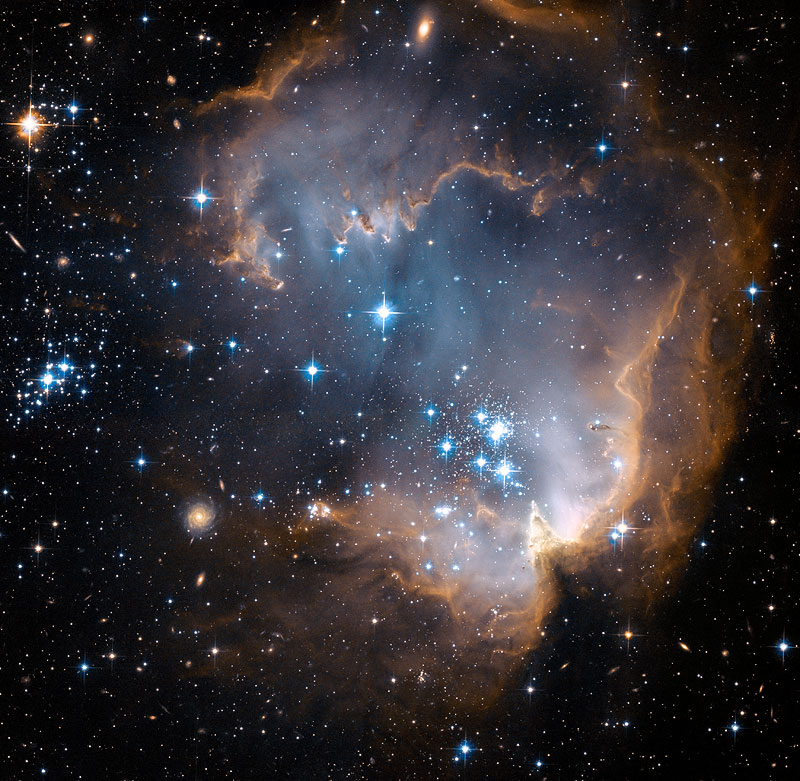
This new image taken with NASA's Hubble Space Telescope depicts bright, blue,
newly formed stars that are blowing a cavity in the center of a star-forming region in the Small Magellanic Cloud.
At the heart of the star-forming region, lies star cluster NGC 602 (at R.A. 1h 29m 31s, Dec. 73° 33' 15" S),
approximately 196,000 light-years from Earth.
The high-energy radiation blazing out from the hot young stars is sculpting the inner edge of the outer portions of the nebula,
slowly eroding it away and eating into the material beyond.
The diffuse outer reaches of the nebula prevent the energetic outflows from streaming away from the cluster.
Ridges of dust and gaseous filaments are seen towards the northwest (in the upper-left part of the image) and towards the southeast (in the lower right-hand corner). Elephant trunk-like dust pillars point towards the hot blue stars and are tell-tale signs of their eroding effect. In this region it is possible with Hubble to trace how the star formation started at the center of the cluster and propagated outward, with the youngest stars still forming today along the dust ridges.
The Small Magellanic Cloud, in the constellation Tucana, is roughly 200,000 light-years from the Earth. Its proximity to us makes it an exceptional laboratory to perform in-depth studies of star formation processes and their evolution in an environment slightly different from our own Milky Way.
Dwarf galaxies such as the Small Magellanic Cloud, with significantly fewer stars compared to our own galaxy, are considered to be the primitive building blocks of larger galaxies. The study of star formation within this dwarf galaxy is particularly interesting to astronomers because its primitive nature means that it lacks a large percentage of the heavier elements that are forged in successive generations of stars through nuclear fusion.
These observations were taken with Hubble's Advanced Camera for Surveys in July 2004.
Filters that isolate visible and infrared light were combined with a filter that samples the hydrogen and nitrogen emission from the glowing clouds.
Release Date: 3:30PM (EDT) January 8, 2007
Release Number: STScI-2007-04
For more information, contact:
Antonella Nota,
Space Telescope Science Institute, Baltimore, Md.
(phone) 410-338-4520, (e-mail) nota@stsci.edu
Lynn Carlson,
Johns Hopkins University, Baltimore, Md.
(phone) 410-338-3014, (e-mail) carlson@stsci.edu
Ray Villard,
Space Telescope Science Institute, Baltimore, Md.
(phone) 410-338-4514; (e-mail) villard@stsci.edu
Lars Lindberg Christensen,
Hubble/ESA, Garching, Germany
(phone) 49-(0)-89-3200-6306; (cell phone) 49-(0)-173-3872-621; (e-mail) lars@eso.org
Credit for Hubble Image:
NASA,
ESA,
and The Hubble Heritage Team
(STScI/AURA).
The original version of this work, with more images and videos, is available at the
STScI WWW server.
Updated: June 22 '07
Best seen with MS Internet Explorer.
Back: Hubble Observes Infant Stars in Nearby Galaxy
Messages: